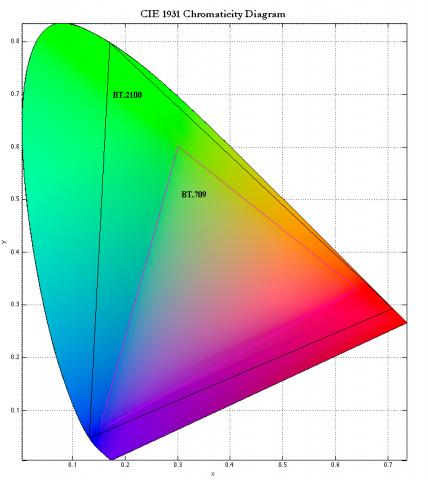
by Philip Merrill, September 2018
High Dynamic Range (HDR) and Wide Colour Gamut (WCG) pose several challenges to deployment such as the need for 10-bit sample data. Managing emerging technical details is necessary for engineers to present audiences and all users with visual screens that present more of the brightness, darkness and colours that they are daily accustomed to in their visual experience of the real world. Fortunately for this transition, High Efficiency Video Coding (HEVC) is already predisposed for 10-bit HDR and WCG use. Electronic and logical requirements for processing Ultra-High Definition (UHD) MPEG of this richer and deeper variety is embedded in silicon, widely deployed in consumer UHD home theater, television screens.
Contrast is an extremely informative visual phenomenon in itself and different experiences of contrasts evoke a wide range of deeply embedded reactions. HDR increases the brightness as well as the darkness by powers of 10. HDR bumps brightness from Standard Dynamic Range's (SDR) 100 to HDR's 1,000 candelas per meter squared. It also improves darkness from 0.1 to 0.0005 cd/m2. This supports a palette of contrasts much more rich than the effect one would get from merely stretching an SDR signal to the extremes, which does more to skew colours rather than actually adding visual information.
Whether in broad solids or in striking highlights, HDR and WCG are inherently dramatic, defining object boundaries, making them stand out, and conveying a sense of texture. White foam on waves or the gleam of a golden statue can be rendered more truthfully in HDR provided that the data is captured and encoded in a manner capturing this greater richness in the data. Large areas of darkness on screen will inherently are enormously more resistant to blotchy banding artefacts once able to represent darkness with richer data and deeper black.
More-saturated colours are the stand-out advantage of WCG displays. This increased palette can be depicted as a larger containing triangle, comparing WCG colour to the BT.709 standard colour range, mapped in colour-space. We'll discuss the details below, however in addition to permitting colours of greater vibrancy, benefits present themselves within the standard range-triangle of colour limits, which now can be denser and richer, with more granular information capacity ready for use, when appropriate for the video content.
For example clouds against a blue sky and dirt peppered with desert vegetation are conventionally known to be rich in detail and enjoyable to appreciate. Delivering such experiences by way of screen displays has always been a pleasurable part of enjoying captured and reproduced imagery. New artificial combinations of colours are enabled as well as more granular and accurate reproductions of realistic scenes. Forest greenery is already better managed now by HEVC, because improved colour was anticipated in the HEVC Main 10 Profile's design phase.
The Main 10 Profile of HEVC anticipated using the 10 bits needed for HDR and WCG because the color standard BT.2100 requires 10-bit accuracy. As for brightness, transfer functions manage the transition from code to display. The gamma function used by Standard Dynamic Range video would actually require a minimum of 12 bits to manage the HDR data. HEVC presents two alternative transfer functions using 10 bits, the Perceptual Quantizer (PQ) and the Hybrid Log Gamma (HLG) function. After successful testing for both, guidance documents have been issued for their use and both PQ10 and HLG10 have been adopted by other standards bodies as well as deployed commercially.
In combination, ultra-high definition (UHD) video with HDR/WCG is known to enhance many perceptual experiences. For example, HDR and WCG in tandem will display bright skies with subtle tones, whereas the other alternative must push the color selection toward white to achieve a sense of the sky's greater brightness. Also, the greater contrast in HDR in combination with higher resolution enhances sharpness.
For both artists and industry, leveraging the recent advances in UHD and HDR/WCG presents an appealing vista for what we will see in the future. The new potential to present both life-like worlds and artificial sights is being embraced by creators and consumers. HEVC support assures that the path forward is clear.
